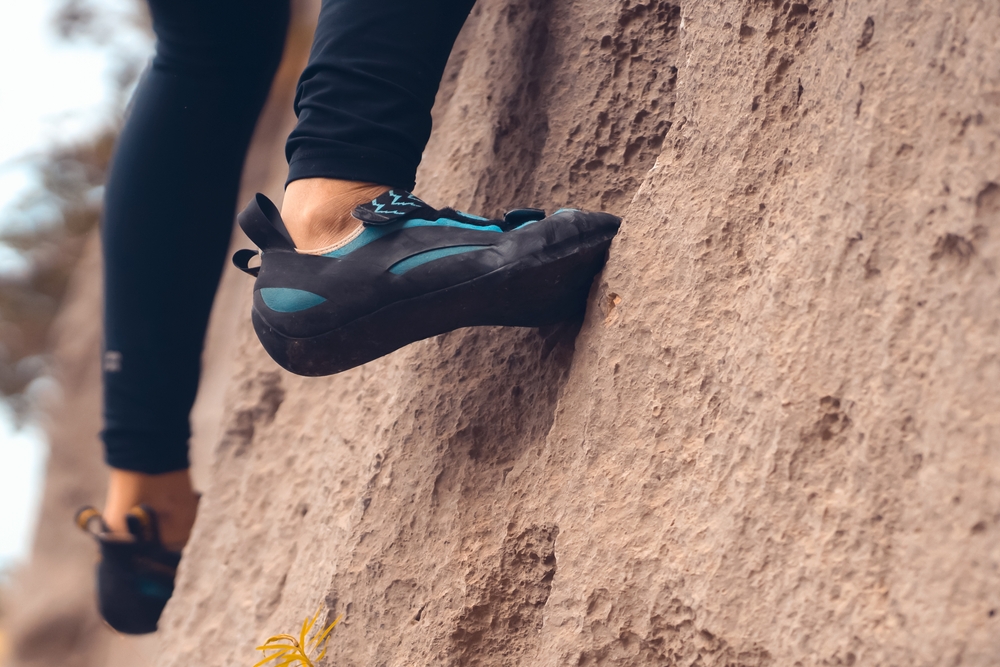Climbing is an activity that can be very demanding on your feet. That’s why it’s important to have the right footwear to protect them. Climbing shoes are designed to accommodate all of the requirements involved in this sport. Let’s take a look at the different types of climbing shoes in terms of their characteristics and how they can better protect your feet.
What is a climbing shoe?
There are many ways in which climbing shoes differ from other types of footwear. Above all, they must fit well and have a good grip on surfaces. Without it, your feet will wiggle in your shoes, and you run the risk of slipping. It is important to note that climbing shoes should be chosen slightly smaller than your normal shoe size. You should not be able to move your toes within them. Also, consider that leather climbing shoes have the potential to stretch more than synthetic ones.
More experienced climbers may choose tighter climbing shoes. If you decide on this type of climbing shoe, it is important to remember to remove them regularly so that your toes can move a little and your feet can breathe. You should never feel pain in your climbing shoes. Try on several shoes in the store and make sure you are comfortable in the ones you choose before buying.
Choosing the right climbing shoe for your needs
Everyone has different needs. The decision of which climbing shoe to choose will depend on yours. First, you need to understand the level of your climbing ability. If you are a beginner, you should choose a flatter shoe. It will give you better protection by providing more support for your foot. If you’re more experienced and enjoy more strenuous climbing, consider a more advanced type of climbing shoe. This means that the arch of the shoe will be more accentuated. The prominent arch will allow for a better grip on smaller holds. You should also take into consideration the rubber of the sole. The softer it is, the more grip it will have. The harder it is, the better it will support your feet on smaller holds. Therefore, we recommend a softer climbing shoe for beginners, while more experienced climbers can opt for a stiffer model.
The different shapes of climbing shoes
Climbing shoes are designed for all kinds of purposes. Some have laces, which allows for a better fit, while others are made with hook and loop fasteners, allowing them to be put on and taken off more quickly. Women’s shoes are usually narrower, and more arched at the arch and instep. In addition, we can mention the level of asymmetry of the climbing shoe, in other words, the curve that it has. Some shoes are more curved than others. A low arch is ideal for long routes, cracks and slabs. A medium arch is best for smaller holds and more complex climbing routes. Lastly, a high arch is designed to keep the weight of your foot centred on your big toe. These shoes are designed for performance, which is why we recommend them for more experienced climbers who are ready to take on bigger challenges. Try them on in the store so that you can better assess what is most suitable for your feet. Keep in mind that the longer you wear them during your climbing activities, the better they will fit your feet.
How do climbing shoes protect your feet?
Climbing shoes protect your feet if they are well-adapted to your needs. You may be at risk of injury if you choose a shoe with a low arch and climb on narrower holds or if you like to climb on slopes. Low-arch climbing shoes are more suited for long routes. High arch climbing shoes, on the other hand, are designed to help you meet the challenges of tighter grips.
Climb in harmony with your feet
While climbing can be quite thrilling, it is an activity that is quite strenuous on your feet. This is why it is so important to choose climbing shoes that fit your feet. As we have seen, there are shoes of all kinds, for all foot shapes, for all levels of ability and for different types of climbing. If you take all these variables into consideration, you have a better chance of choosing the right climbing shoe that will fit your needs and protect your feet. Don’t hesitate to contact your podiatrist if you have any doubts or questions.

